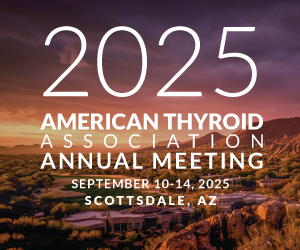
Vibhavasu Sharma, MD, FACE
Albany Medical College, Albany, NY
August 13, 2020
Thyroid disease is commonly encountered during pregnancy. Women may already have the diagnosis prior to conception or may be first diagnosed after becoming pregnant. In the absence of thyroid disease, the gland is able to compensate for increased demand during pregnancy. However, gestation does present unique challenges to thyroid hormone management. Our current scientific understanding can provide some practical guidance to optimize care.
Maternal hypothyroidism is defined as a thyroid stimulating hormone (TSH) concentration above the trimester specific reference range. Use of population and trimester specific reference ranges is ideal, but is often not available. When not available, a TSH level above 4 mU/L may be used for diagnosis.
Women who already have a known diagnosis of hypothyroidism prior to pregnancy should have preconception counseling regarding disease management during pregnancy. A discussion of the goals of treatment and potential adverse maternal and fetal/child health outcomes is recommended.
Levothyroxine dose should be adjusted to target a TSH level between the lower limit of the reference range and 2.5 mU/L. The patient may be advised to increase the dose of levothyroxine by 20 to 30 % as soon as pregnancy is confirmed to avoid any inadvertent delay. One way to achieve this easily is by increasing the dose by two extra daily doses a week.
Continuation of or starting the use of desiccated thyroid or triiodothyronine(T3) preparations is not currently recommended during pregnancy. It is believed that thyroxine (T4) is essential for the developing fetal brain. The high ratio of T3 to T4 in these preparations may lead to a decreased transfer of maternal T4 to the fetal brain across the placenta, which is impermeable to T3.
Thyroid function testing should be done frequently, at least once every 4 weeks or with any dose changes to ensure the goals of therapy are being met. The frequency may be reduced after mid gestation. Levothyroxine should be adjusted based on the TSH values, with the recommended goal being a TSH in the lower half of a trimester-specific reference range, or simply a TSH below 2.5 mU/L when using a standard reference range.
For women not previously diagnosis with hypothyroidism or not taking levothyroxine, another issue of importance is subclinical hypothyroidism. For pregnancy, this is defined as an elevated TSH >4 mU/L, or above the pregnancy specific references range, in the presence of a normal serum T4 (thyroxine) concentration. This is where testing for the thyroid antibody levels may be particularly useful. Although there are limitations to the available data, it is recommended that women with subclinical hypothyroidism who have positive thyroid peroxidase (TPO) antibody levels be treated with levothyroxine. The potential benefit of this approach is a reduction in the rate of miscarriage (this risk has been shown to be higher in women who have this antibody). In the absence of TPO antibody, however, a higher TSH level of 10 mU/L may be utilized as guide to start treatment. Some endocrinologists may choose however, to initiate therapy at a TSH level below this number.
Two very important situations are worth noting. Women who take levothyroxine due to the previous treatment of Graves’ disease should have a TRAB (thyroid receptor binding antibody) level checked early in pregnancy and again around 18 to 22 weeks gestation if initially elevated. This is due to the increased risk of placental transfer and resulting fetal/neonatal hyperthyroidism/goiter. In patients with positive antibodies, obstetricians may need to follow the pregnancy closely with serial fetal ultrasounds and postnatal thyroid function tests.
It is also important to remember to readjust the levothyroxine dose post-partum. Levothyroxine can typically be returned to the pre-pregnancy dose. The patient should have thyroid function testing about 6 weeks post-partum and the dose may be now adjusted to a goal of keeping the TSH in the normal range. Women who did not have hypothyroidism before pregnancy and do not have immediate plans for future fertility may consider discontinuation of levothyroxine.
A careful evidence-based approach to the management of hypothyroidism with preconception counseling, close laboratory monitoring and keeping the goals of treatment with levothyroxine in mind can help manage the condition well and reduce the risk of adverse outcomes.
For further reference:
Thyroid Disease in Pregnancy Brochure | by the American Thyroid Association
Disclaimer:
The ideas and opinions expressed in the ATA Thyroid Health Blogs do not necessarily reflect those of the ATA. None of the information posted on link to blog page is intended as medical, legal, or business advice, or advice about reimbursement for health care services. The mention of any product, service, company, therapy or physician practice on link to blog page does not constitute an endorsement of any kind by ATA. ATA assumes no responsibility for any injury or damage to persons or property arising out of or related to any use of the material contained in, posted on, or linked to this site, or any errors or omissions.



